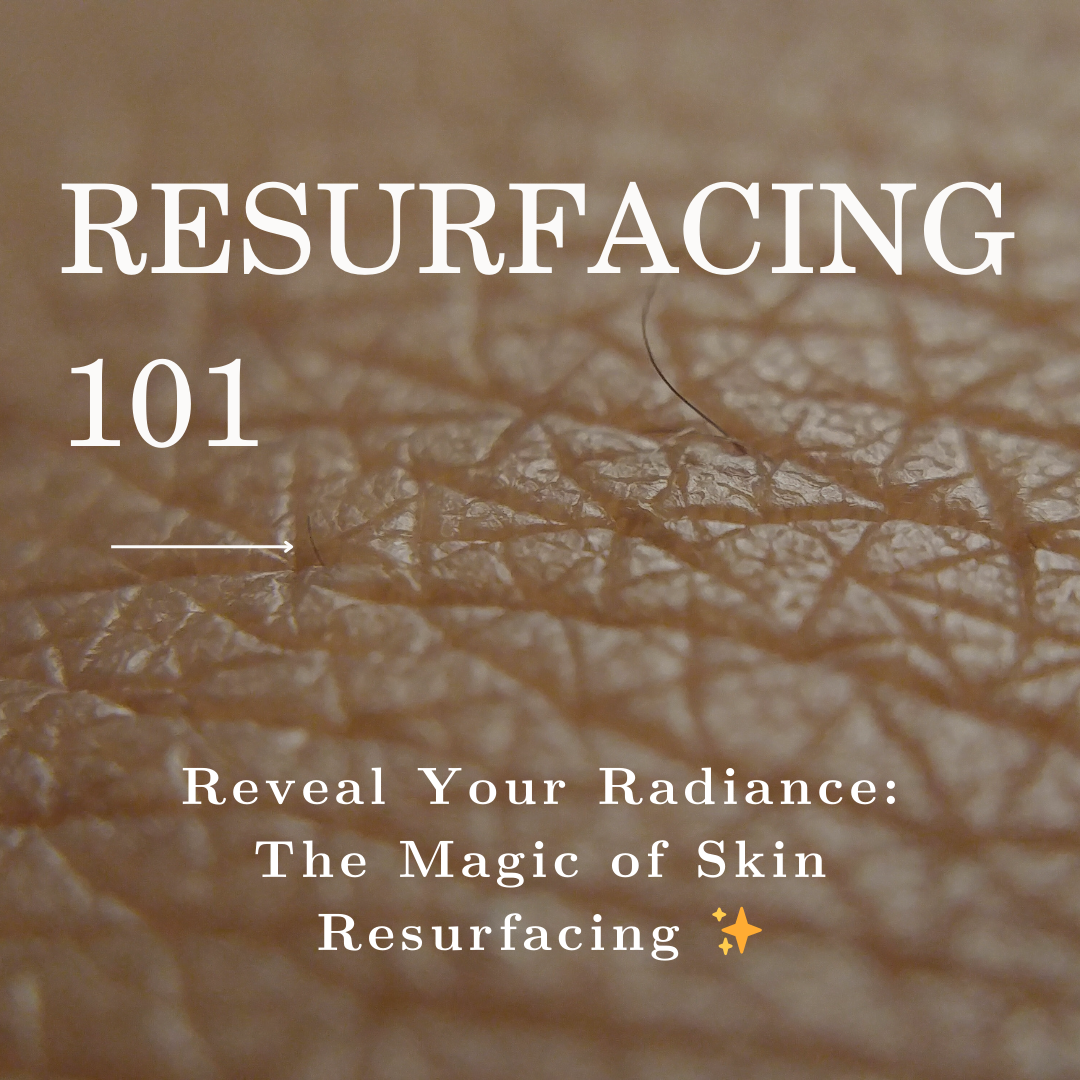skin RESURFACING 101

Skin resurfacing is a cosmetic procedure aimed at improving the texture, tone, and overall appearance of the skin. There are various methods of skin resurfacing, each offering unique benefits:
- Microdermabrasion: This non-invasive procedure involves the use of a handheld device to gently exfoliate the outer layer of the skin, removing dead skin cells and promoting cell turnover. Microdermabrasion is effective for improving the appearance of fine lines, wrinkles, acne scars, and sun damage. It also enhances the penetration of skincare products, making them more effective. BOOK HERE
- Chemical Peels: Chemical peels involve the application of a chemical solution to the skin, which causes the outer layer to peel off, revealing smoother, younger-looking skin underneath. Chemical peels can vary in strength, from superficial to deep, and can address a range of concerns such as acne, hyperpigmentation, and uneven skin tone. BOOK HERE
- Laser Resurfacing: Laser resurfacing uses concentrated beams of light to remove the outer layer of the skin and stimulate collagen production. It can effectively treat wrinkles, age spots, acne scars, and uneven skin texture. Laser resurfacing can be ablative (removing the entire outer layer of skin) or non-ablative (targeting deeper layers of skin without removing the surface).
Benefits of skin resurfacing include:
- Improvement in skin texture: Resurfacing treatments can smooth out rough, uneven skin texture, leaving the skin soft and supple.
- Reduction of fine lines and wrinkles: By stimulating collagen production and promoting cell turnover, resurfacing treatments can diminish the appearance of fine lines and wrinkles.
- Evening out skin tone: Resurfacing treatments can fade pigmentation issues such as sunspots, age spots, and melasma, resulting in a more even skin tone.
- Treatment of acne scars: Resurfacing treatments can minimise the appearance of acne scars by removing damaged skin cells and promoting new collagen growth.
- Boosting collagen production: Many resurfacing treatments stimulate collagen production, which helps improve skin elasticity and firmness over time.
- Enhanced absorption of skincare products: By removing the outer layer of dead skin cells, resurfacing treatments allow skincare products to penetrate more deeply into the skin, increasing their effectiveness.
Overall, skin resurfacing can rejuvenate the skin, leaving it looking smoother, brighter, and more youthful. However, it’s essential to consult with a skincare professional to determine the most suitable treatment option based on your skin type, concerns, and goals. Book a FREE FACEMAPPING appointment HERE!
EXFOLATION VS RESURFACING
Exfoliation and skin resurfacing are both methods used to improve the appearance and texture of the skin, but they differ in their intensity, mechanism of action, and the depth of skin layers they target.
- Exfoliation:
- Definition: Exfoliation refers to the removal of dead skin cells from the skin’s surface.
- Mechanism: Exfoliation can be achieved through mechanical means (scrubs, brushes, or exfoliating gloves) or chemical means (using products containing alpha hydroxy acids, beta hydroxy acids, enzymes, or retinoids).
- Depth: Typically, exfoliation primarily targets the outermost layer of the epidermis, known as the stratum corneum.
- Purpose: Exfoliation helps to unclog pores, improve skin texture, and promote cell turnover, resulting in smoother, brighter-looking skin.
- Types: Common methods of exfoliation include physical exfoliation (scrubs), chemical exfoliation (peels, acids), and enzymatic exfoliation (products containing enzymes).
- Skin Resurfacing:
- Definition: Skin resurfacing refers to procedures that remove or remodel the upper layers of the skin to improve its appearance and promote skin regeneration.
- Mechanism: Skin resurfacing procedures typically involve the use of advanced techniques and technologies, such as lasers, microdermabrasion, dermabrasion, or chemical peels, to target deeper layers of the skin.
- Depth: Unlike exfoliation, which primarily targets the superficial layers of the skin, skin resurfacing procedures can penetrate deeper into the epidermis and sometimes into the dermis, depending on the method used.
- Purpose: Skin resurfacing procedures are used to address a wide range of skin concerns, including wrinkles, fine lines, acne scars, uneven pigmentation, and sun damage.
- Types: Common skin resurfacing techniques include laser resurfacing (ablative and non-ablative), microdermabrasion, dermabrasion, chemical peels (superficial, medium, or deep), and microneedling.
For a full range of exfoliation products CLICK HERE
In summary, while both exfoliation and skin resurfacing aim to improve skin texture and appearance, exfoliation primarily targets the superficial layers of the skin to remove dead cells, while skin resurfacing procedures penetrate deeper into the skin to address more specific skin concerns and promote skin regeneration.
For more information, please don’t hesitate to get in touch!
07736737337

